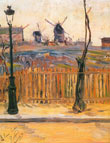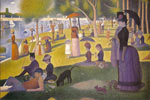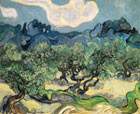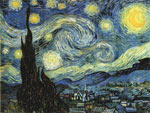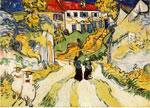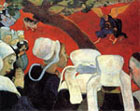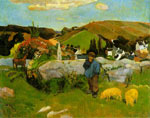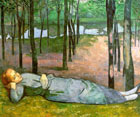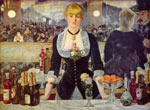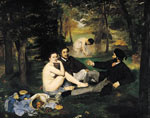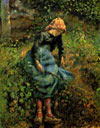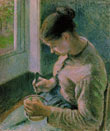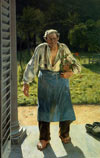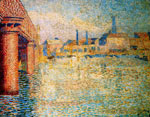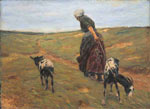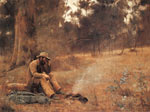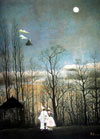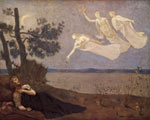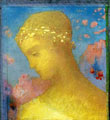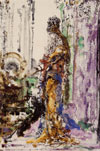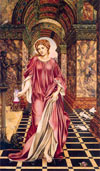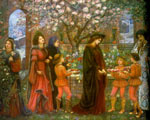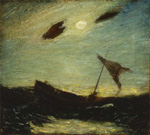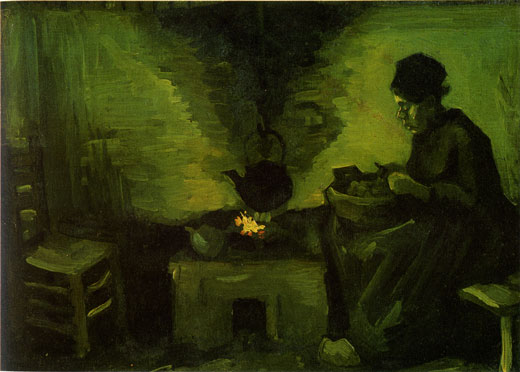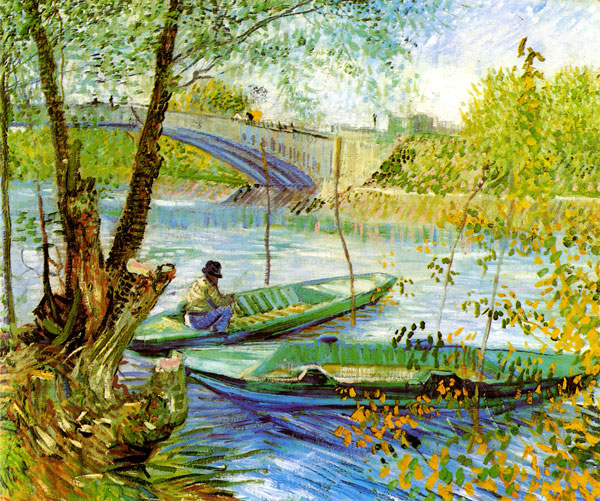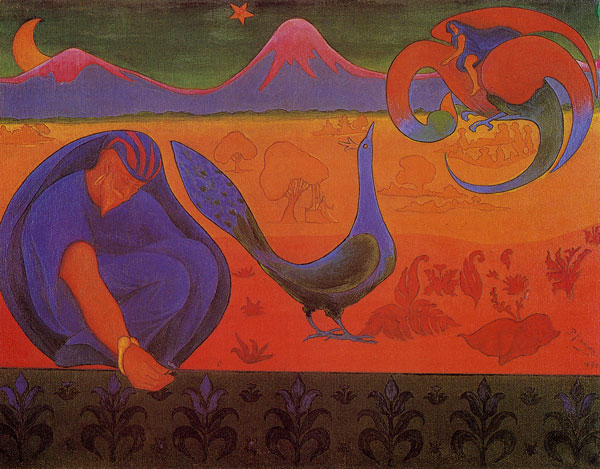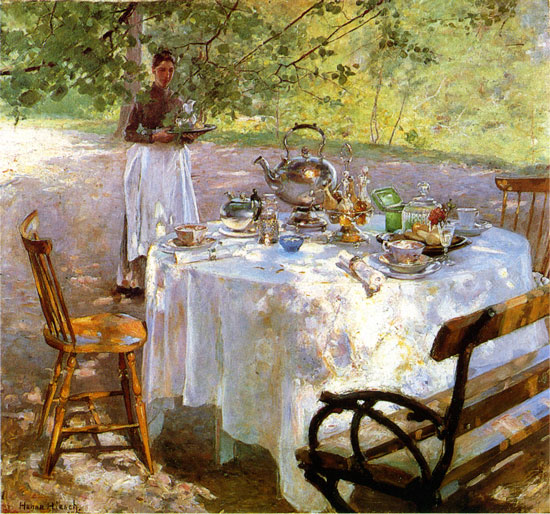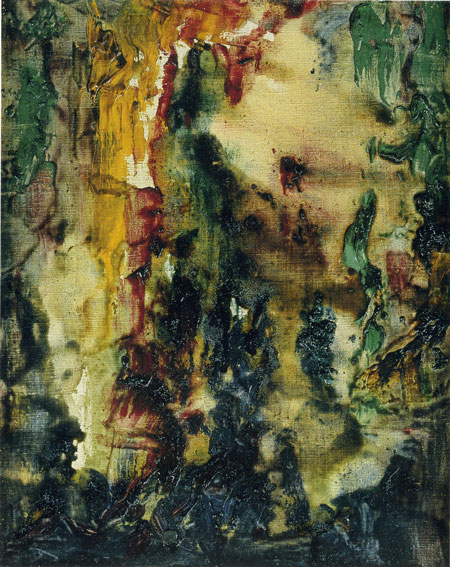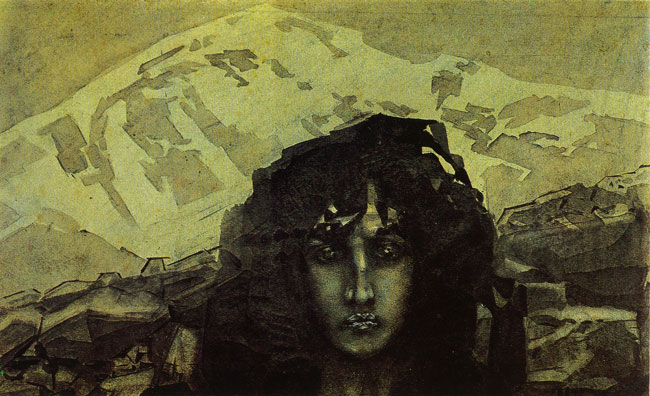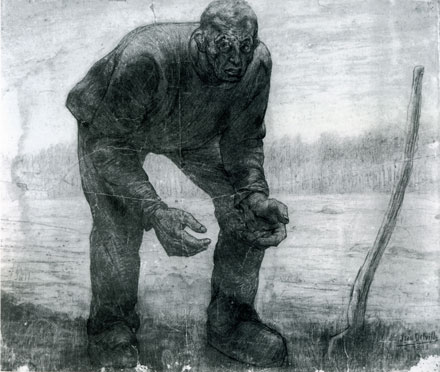
Moving Movements, History of Modern Painting, 1880 - 90
THE YEARS 1880: A CALEIDOSCOPE OF STYLES
In 1879 Thomas Alva Edison invented the first incandescent lamp, able to brun for a reasonable amount of time. In 1883 the international exhibiton in Vienna already had electric light. In 1883 Nietzsches "Also sprach Zarathustra" was edited. In 1888 the first celluloid film came on the market and Heinrich Hertz transmitted what we now call radio waves.
click the thumbnails
Paul Signac
Le Moulin de Montmartre 1884
Georges Seurat
Une baignade à Asnières
Georges Seurat
A Sunday Afternoon on the
Island
of La Grande Jatte
Vincent van Gogh
The Olive Trees 1889
Vincent van Gogh
Starry night
Vincent van Gogh
Stairs
Paul Gaugain
The Vision after the Sermon
Jacob wrestling with the Angel 1888
Paul Gaugain
The Swineherd 1888
Emile Bernard
Madeleine in the Bois d'Amour 1888
Emile Bernard
Pieta 1890
Eduard Manet
Bar in the Folies-Bergères 1881
Eduard Manet
Country Breakfast
Camille Pissarro
Shepherdess 1881
Camille Pissarro
Peasant girl
drinking her Coffee 1881
Emile Claus
The old Gardener 1885
Jan Toorop
Bridge in London Sun 1889
Max Liebermann
Woman with Goats in the Dunes 1890
CamMc Cubin
Down on his luck 1889
Henri Rousseau
Carnival Evening 1886
Pierre-Cécile Puvis de Chavannes
The Dream 1883
Odilon Redon
Béatrice 1875
Gustave Moreau
Woman with a Panter 1880
Michael Vroebel
The Demon (sitting) 1890
Eveline de Morgan
Medea 1889
Maria Euphrosyne Spartali Stillman
The enchanted Garden
of Messer Ansaldo 1889
EveArnold Böcklin
Island of the Dead 1883
Max Klinger
the Judgement of Paris
(Paris Valg)1886-87
Albert Pinkham Ryder
Moonlight, 1887
Style renewers, called neo-impressionists
Although
Degas, Monet, Renoir, Manet and Pissarro made their most beautiful paintings in those years, and ever more painters were converted to impressionism (as for example Caillebotte), some artists arose in France which wanted to work different again. Some of them are thrown in a bag with the artificial name "neo-impressionism".
As if they were evolving from impressionism, what was not the case for everyone, as for example Van Gogh. They were more the result of the growing courage to work on a personal, specifique way.
Signac started working in a rough expression with large strokes, as in "Le
moulin de Montmartre", 1883-84. (Click on the thumbnails in the colon on the right.)
Vincent Van Gogh, Woman Farmer at the Hearth-fire, 1885 |
Seurat's "Une baignade à Asnières" was already inclining towards pointillism, but he still used tight, short brush strokes, criscross intermingled. His two versions of "Dimanche après-midi à la grande Jatte" are completely in stripes of diverse colours, even the contours. In 1888 he worked in minuscule spots. Seurat called his style "chromoluminarism" and later "divisionism". Van Gogh painted as a late realist in ashen, dull colours and in rough brush strokes: the poor, their profession and habitat; also nature, still lifes and portrets. In 1885 he painted his famour potatoe eaters. |
Vincent Van Gogh, Fisherman and Boat at the Bridge of Clichy, 1887 |
He became rich in colour when starting his "Japanese paintings ". In 1888 he varies his style often, now a fine figuring on canvas, then a large monotonious area as if grounded. His first undulating paintings arose. Sometimes he pushed the paint from the tube directly on the canvas. From that same year dated his quarrel with Gauguin, in witch he cutted off one of his ears, and his hospitalization in psychiatry. In 1889 he made his undulating cypresses, olive orchards and the starry night with spirals. Afterwards the undulating disappeared agian, to make place for tight little stripes and contours, for example "Corn with Raven". He ended with acres in mixed style. His productionraised hight in a short time, but in 1890 he ended his life. |
Paul Ranson, Paysage nubique, 1890 |
Gauguin,
the dull realist, started working more colourful from 1885. In 1887 he started his adventurous and lawless life. In 1888 he had his own specific style, as in "La lutte de Jacob avec I'ange", with clearly bordered coloured areas. Each of those areas has his colour due to the mixing of the varying colours, a technique he lent from Degas. The areas are plainly contoured with gracious, undulating lines, a characteristic of Art Nouveau. Within each of those areas there is relative little figuration? His figures are somewhat naieve an are more of the common people then the middle class. Sometimes he works in symbolism. |
Emile Bernard painted more or less in Gauguin's style and others will follow them and call themselves nabis. Paul Ranson made in this direction the very stylised, almost surrealist "Paysage nabique" in 1890. Filiger the painted "Paysage du Pouldu": so much stylised it looks like an abstract puzzle.
We return now to the impressionists. Cézanne always worked completely different and experimented a lot. He started working in strokes of different mixed colours, a lot more colourful (1882 tot '85). De The strokes are big and in a particular direction. They look a bit like facets. Distant houses are painted completely in such facets. Later on he preferred to work more in spots then strokes, covering (not transparant), but clearly outstanding, often with strongly profiled. Monet, Renoir and others never worked with such contours.
Degas, also very varying in his oeuvre, resmbles more Gauguin then Monet or Renoir. Manet's style is very obvious in his "Le bar aux Folies-Bergère", from 1881: the human skin is not painted in severla colours as for example Monet and Renoir do, but nevertheless the work is rich of colour by it's diversity of colourful subjects depicted, reinforced by means of the mirror. Although Pissarro didn't like pointillism, he did look quite similar; instead of dots he did put thin linesside by side (as Previati did), radiating colour and light. Instead of the bourgeoisie he choosed to depict the simle people (as a result he remained poor himself), of their landscape, the hills as well as the cities. Pissarro heavily critisized symbolism, as he did with occultism en boeddhism, which he regarded as bourgeoisie entertainment. That's the reason he also opposed Gaugain, his former pupil.
| Outside France similar styles are noticed. Scandinavie for example had beautiful impressionists : Heyerdahl ("At the Window", 1881),
Philipsen, Nordström, Kreuger, Krohg, Werenskiold. The most brilliant was Hanna Pauli, for example her "Breakfast" (1887). The "Unmasked"
from Gallen-Kallela (1888) is flamboyance by means of the subject (as with
Manet). In Belgium Emile Claus gradually evolved from realism to his delightful trembling light. The posterior pointillist van Rysselberghe still preferred to align his subjects sharper. Also Van de Velde,
Finch, Lemmen, and the Dutchman Toorop painted in dots. Beside other painters held on to realism, for example the Belgians Baertsoen, Meunier and in that period also Ensor. Even in the years 1890 Belgium still had new realists, but their style verged towards impressionism. |
Hanna Pauli, Breakfast (Frukostdags), 1887 |
In Germany Liebermann and Von Uhde painted in many colours, sometimes a very realitic socialism, this style more resembling Jongkind or Boudin, then impressionists. In Australia Mc Cubbin painted "The lost child" in 1886, a very beautiful and personal impressionism, representing adequate the wildness of nature. Conder made very sketchy his miniature paintings on cigar boxes.
Who didn't belong to the impressionists, nor to the "neo's", is Rousseau. Because Henri Rousseau did't follow any lead-up, he didn't belong to any current movement. He devellopped his personal, naive style according to his own sense of beauty. His "Soir de carnaval" (1886) radiates a poetical mood.
Gustave Moreau, Ebauchee abstraite, ca. 1890 |
There is still more diversity to find in the paintings of the so called
symbolists. Puvis
de Chavannes still continues painting mythological scenes in fresco colours. The artist sometimes deviates from reality to create a special and odd mood. Odilon Redon's subjects are symbolistic, but the technique he now uses belongs more to the nabi's. Moreau goes on experimenting: his watercolours often have an impressionist background. He paints "Angel of Death" in 1890 in
a pure expressionistic style, with a thick layer of paint. The "Torment
of Saint Antony" is a completely abstract aquarelle. Some of his works he tittles as "Ebaute abstraite". He also combines figures with an abstract surrounding. In 1892 he became teacher in the Ecole de Beaux
Arts. Rodin, a symbolist sculptor, worked from 1880 to '87 at his "Gate of Hell". |
In Russia Vroebel painted in 1886 in small squares, stripes and dots, without knowing Seurat or Signac. Sometimes he also painted in a mosaic like patter. His "Head of a demon" with transparent overlapping squares, looks nowadays. Vroebel was one of the founders of the "modern style" in Russia, and the most original one. Except painting in oil or watercolour, he also made sculptures, ceramics, and also was a book illustrator, scenographer and architect. A lot of his works were made on the estate of Abramtsevo nearby Moskow. |
Michael Vroubel, Demon Head, 1891 |
![]() In England the number of Pre-Raphaelites was still growing: Evelyn de Morgan painted very colourful, with a lot of glaze spots, playful figures, sometimes a bit surrealistic. Maria Stillman painted in 1889 her "Entchanted Garden": very precise, with an idealistic flora, natural and spontaneous body postures and above all brilliant in colour. Strudwick painted his very detailed scenes in gold and ochres, but never dull.
In England the number of Pre-Raphaelites was still growing: Evelyn de Morgan painted very colourful, with a lot of glaze spots, playful figures, sometimes a bit surrealistic. Maria Stillman painted in 1889 her "Entchanted Garden": very precise, with an idealistic flora, natural and spontaneous body postures and above all brilliant in colour. Strudwick painted his very detailed scenes in gold and ochres, but never dull.
The Swiss Böcklin painted his "Island of the Dead": apparently in an old style, with clear influences of Caspar David Friedrich, but in a composition of diverse geometric forms: round rocks, candle form cypresses, dark and light rectangles. The soft yellow light contrasting with the almost black shadow creates a dramatic effect and a magical mood. (Click on the thumbnail in the right colon.)
Also in Belgium symbolism now aroused. Soon Ensor left his Manet-like realism by rich colours and a clear paint structure in a technically high skill. His most revolutionary works are those full of wild stripes where now and then a little figure emerges, form very vague to more specific, as Turner did before. For example his "Temptation of Saint Antony" (1887), "Christ furious " (1888),
"The defeated Angels " (1888), "Christ calming the Storm"
(1891), "The Garden of Love" (1891). He also made a lot of caricatures or painted masks, also in still lifes and portraits.
Even in his still lifes something of the apocalyptic, twisting lines and vibrating colours remain. Ensor is often classified with symbolism, impressionism,
expressionism, in other words, he doesn't belong anywhere.
In
1888 - '90 Ciamberlini, Montald and Jean Delville found their way to symbolism.
Before Delville was very socially oriented, his work reminded the later Flemish painter
Permeke. Mellery was drawing and painting mysterious black and white interiors.
| If painting suddenly flourished in Belgium and got international importance, it was surely due to the art collector Octave Maus, who founded in 1883 "Les XX". They held an exposition each year, where different painters exposed there work in various styles. Their purpose was close to the purpose of this essay: to show how artists can express themselves in so many different ways. Beside sales, Les XX also brought on mutual contacts and friendship. There where also foreigners exposing: in 1883 Whistler, Seurat, Gaugain and Denis (a nabi). Even to the French painters Les XX became an exposition in demand. Seurat sold there his first works. Traditionals had their place between impressionists; Ensor, Gauguin and Van Gogh together with pointillists, as well as more and more symbolists, such as Mellery or Khnopff. In 1891 also ceramics where added. In 1893 "Les XX" changed into "La libre esthétique": the name speaks for itself! But now it was less democratically run by Maus himself. |
Jean Delville, Farmer, 1888 |
World-wide, of better Europe-wide, an amount of new symbolists came up as a geyser. They will continue to create until the First World War. To mention some: Davies, Point, Maison, Gallen-Kallela, Homel, Munthe, Preisler, Marianne Stokes, Von Stuck, Bilek, Thorn-Prikker, Schwabe, Kubin, Heive, Frédéric (is also a realist), Arosenius, Arnold Schönberg (yes, the componist), Pellizza da Volpedo, Hawkins, Leduc, Keller, Osbert, Janmot (in 1854 he already reminded Paul Delvaux!), Grasset, Mossa, Moser, Osbert de Volpedo (a pointillist), Stjornschantz (Finland), Wojtkiewicz, Wyspianski, Mehoffer, Klinger, Carrière, Preisler, Hynais, Traquair (silk and gold thread embroided on canvas), Mackintosch, Trachsel, Van Doesburg, and so on... Furthermore there also where a lot of symbolist photographers: Holland Day, Hofmeester, Steichen, Käsebier, Brigman, Bufka, Dubreuil, Stieglitz, Eugene, Robinson, White, Seeley, Von Gloeden, Embeck... A lot of photos were retouched in several ways, for example with a paint brush, what brings them closer to the art of painting.
Copyright for the text of all pages of this History of Modern Painting: Johan Framhout; text written in 1990-92; revisionned and put on the internet in 2005; translation in English 2012

